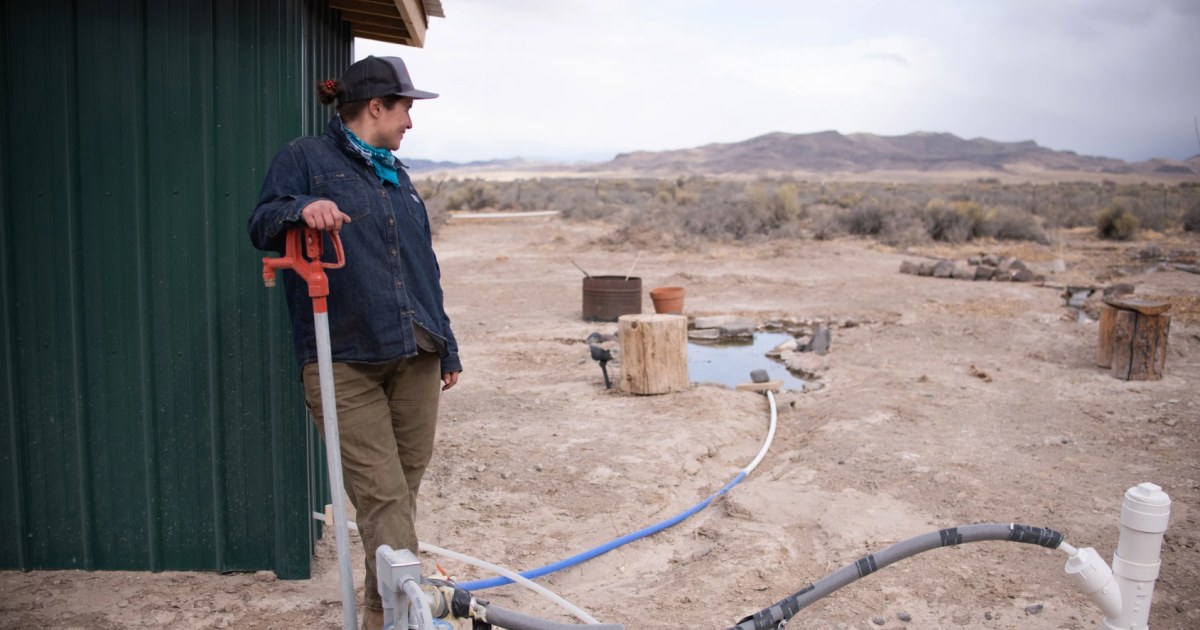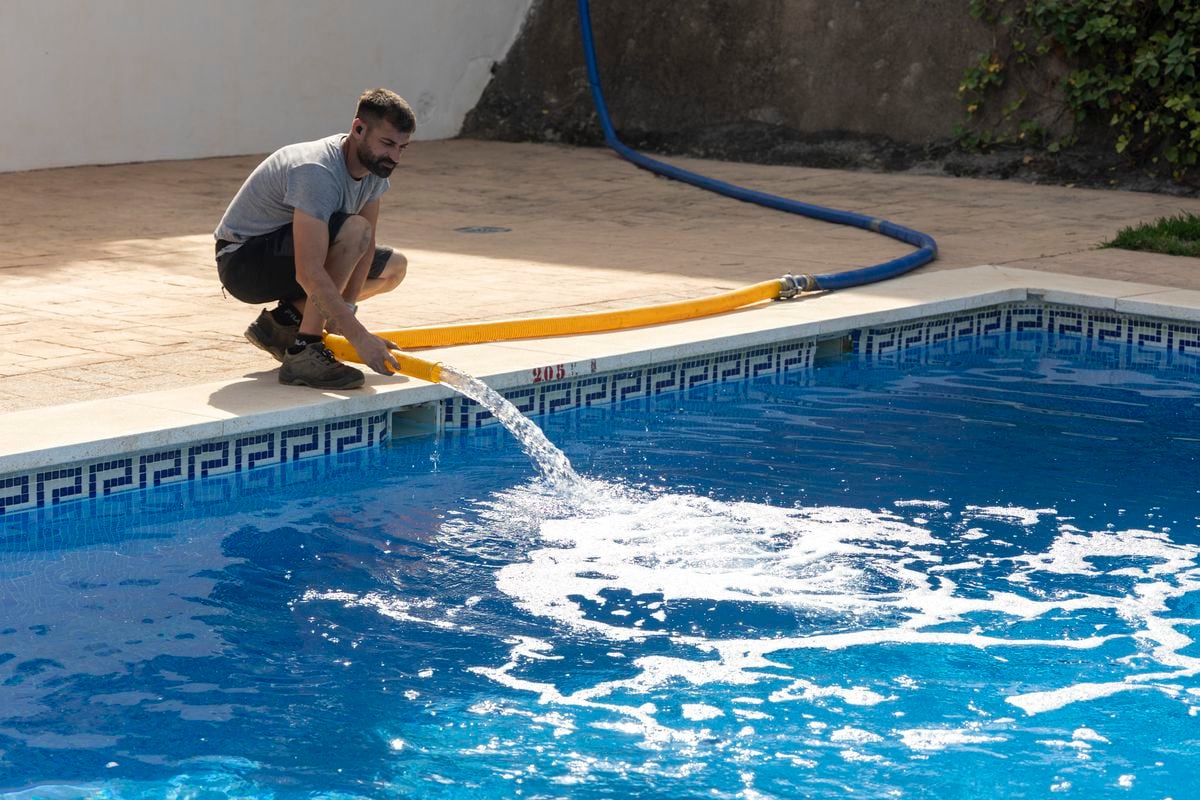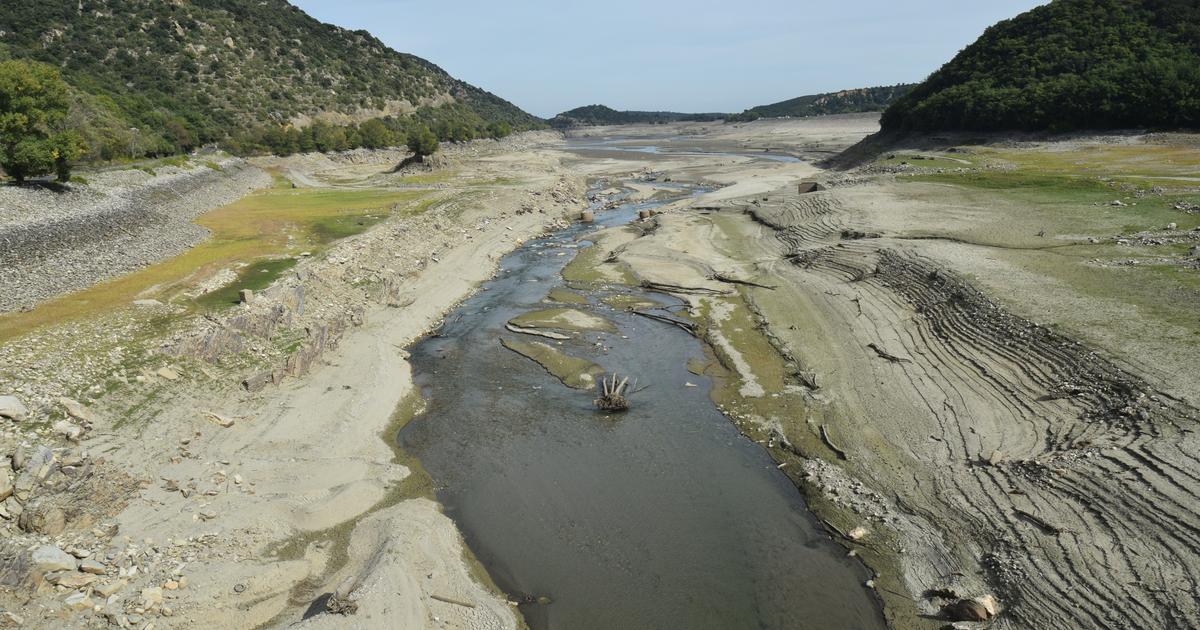By Melissa Bailey — KFF Health News
When John Mestas' ancestors moved to Colorado more than 100 years ago to raise sheep in the St. Louis Valley, "they came to paradise," he said.
"There was so much water they thought it would never run out," Mestas said of the agricultural region at the head of the Rio Grande.
Now, decades of drought driven by climate change, combined with overexploitation of aquifers, are leaving the valley desperately dry, and this appears to be intensifying levels of heavy metals in drinking water.
Like a third of the people living in this high-altitude alpine desert, Mestas relies on a private well that draws water from an aquifer for drinking. And, like many farmers in the area, he uses the same source to irrigate the alfalfa he feeds his 550 cows.
"Here, water is everything," he said.
Mestas, 71, is now one of hundreds of well owners participating in a study that addresses the question: How does drought affect not only the quantity, but also the quality of water?
John Mestas and his daughter Angie are among hundreds of well owners in Colorado's St. Louis Valley participating in a study on drought and water quality. Melissa Bailey/KFF Health News
The study, led by Kathy James, an associate professor at the Colorado School of Public Health, focuses on arsenic in private drinking water wells. Arsenic, a carcinogen found naturally in soil, has been showing up at increasing levels in the valley's drinking water, according to James.
In California, Mexico and Vietnam, research has linked rising levels of arsenic in groundwater to drought and overexploitation of aquifers.
As the West battles a mega-drought that has lasted more than two decades and states risk water cuts from the dwindling Colorado River, the San Luis Valley offers clues as to what the future may hold.
[Supreme Court Weakens Government's Power to Monitor Water Pollution by Restricting Environmental Law]
Nationwide, about 40 million people rely on domestic wells, estimated Melissa Lombard, a hydraulics researcher with the U.S. Geological Survey. Nevada, Arizona and Maine have the highest percentage of domestic well users — ranging from about one-quarter to one-fifth of these users — who use water with elevated arsenic levels, another study found.
During the drought, the number of people in the continental United States exposed to elevated levels of arsenic in domestic wells could rise from about 2.7 million to 4.1 million, Lombard estimated using statistical models.
Planet Earth: These circumstances have led to a dangerous boundary to the Colorado River
May 23, 202300:39
Arsenic has been proven to affect health, starting with sperm and eggs, James explained. Even a small exposure, accumulated over a person's lifetime, is enough to cause health problems, he added.
In an earlier study in the valley, James found that lifetime exposure to low levels of inorganic arsenic in drinking water, between 10 and 100 micrograms per liter (μg/L), was linked to an increased risk of coronary heart disease. Other research has linked chronic exposure to low arsenic levels to hypertension, diabetes, and cancer.
Pregnant women and children are at increased risk of harm.
I think it's a problem that a lot of people aren't aware of. Climate change will likely affect water quality."
Melissa Lombard HYDRAULIC RESEARCHER U.S. GEOLOGICAL SURVEY
The World Health Organization sets the recommended limit for arsenic in drinking water at 10 μg/L, which is also the U.S. standard for public water supplies. But research has shown that, even at 5 μg/L, arsenic is linked to higher rates of skin injury.
"I think it's a problem that a lot of people aren't aware of," Lombard said. "Climate change will likely affect water quality," he said, but more research is needed to understand how and why.
A focus of hope
The San Luis Valley, which has been home to a great deal of research and innovation, is the ideal place to explore those questions, and possible solutions.
A storm hits the Sangre de Cristo Mountains in September 2022. Snowmelt and rain in the mountain range drain into Colorado's San Luis Valley, replenishing aquifers. Melissa Bailey/KFF Heatlh News
Known for its stunning mountain views and proximity to Great Sand Dunes National Park and Preserve, the valley encompasses a region roughly the size of Massachusetts, making it the largest alpine valley in North America.
Rich in indigenous, Mexican and Spanish heritage, it contains 500,000 acres of irrigated land producing potatoes, alfalfa for fodder and barley for Coors beer. It is home to nearly 50,000 people, many of them farmworkers and about half of them Hispanic.
[Alarming rise in world temperatures forecast]
It's also a challenging place to live: The counties here are among the poorest in the state, and rates of diabetes, kidney disease, and depression are high.
Since it rains very little, about seven inches a year on average, farmers rely on two large aquifers and the headwaters of the Rio Grande, which continues into Mexico. The thaw of the towering Sangre de Cristo and San Juan mountain ranges recharges the supply each spring.
However, as the climate warms, there is less snow and water evaporates more quickly than normal from both soil and crops. "This whole community, this culture, was built around irrigated farming," said Cleave Simpson, an Alamosa state senator, Republican and fourth-generation farmer.
Planet Earth: Pesticides, arsenic and copper have polluted this lake and generated health problems
April 18, 202304:26
But since 2002, the valley's unconfined aquifer has lost 1 million acre-feet of water, or enough to cover 1 million acres of land with a foot of water deep, due to persistent drought and overuse. Now valley communities face a deadline to replenish the aquifer, or face statewide closure of hundreds of irrigation wells.
"We're a decade ahead of what's happening in the rest of Colorado" because of the intensity of water scarcity, said Simpson, who manages the Rio Grande Water Conservation District.
[Extreme Heat Days Rise in U.S.]
"This is no longer a drought, this is really the desertification of the West," Simpson said. This is how scientists describe a long-term trend toward persistent dryness and aridity that can only be stopped by addressing human-caused climate change.
James, who is an epidemiologist and engineer, has been studying the connections between climate and health in the valley for the past 15 years. He found that during dust storms in the St. Louis Valley, which have become more frequent, more people come to the hospital for asthma attacks. And it has surveyed farmworkers about how drought is affecting their mental health.
Seven States Agree to Reduce Water Use to Save Colorado River
May 23, 202301:24
In studying domestic wells, James is focusing on arsenic, which he said has been gradually increasing in the valley's drinking water wells over the past 50 years. Arsenic levels in the San Luis Valley's groundwater are "considerably higher than in many other areas of the United States," according to James. It is also investigating ethnic disparities, as one study showed that Hispanic adults had higher levels of arsenic in their urine than non-Hispanic white adults. (Hispanic people can be of any race or combination of races.)
Now, James aims to analyze 1,000 private wells in the valley to explore the connections between drought, water quality and health. So far, he said a small proportion of the wells show elevated levels of heavy metals, including arsenic, uranium, tungsten and manganese, which are naturally found in the soil.
[Biden Administration Proposes First Cap on Greenhouse Gas Emissions from Power Plants]
Unlike public water supplies, private domestic wells are unregulated and can go years without being tested. James offers free water testing and consultation on the results to participants. In Conejos County, John Mestas' daughter, Angie Mestas, jumped at the chance to do a free test, which would cost $195 at a local lab.
Angie, a 35-year-old teacher, said she used her life savings to drill a drinking water well on her land, an open field of chamisa grass with panoramic views of the St. Louis Hills. But you won't drink from this well until tests are done for arsenic and E. coli, which are common in the area.
Angie Mestas used her life savings to drill a drinking water well on her land in Los Sauces, Colorado. But you won't drink that water until you test for arsenic and E. coli. Melissa Bailey/KFF Health News
While he awaits test results, he has been carrying 5-gallon barrels of water from his father's house every time he spends the weekend in his new tent.
Threat without smell or color
Meanwhile, Julie Zahringer, whose family settled in the valley from Spain nearly 400 years ago, has been observing water quality trends firsthand.
Zahringer, 47, grew up driving a tractor on his grandfather's ranch near St. Louis, Colorado's oldest city, and spent time in the lab with his mother, who is a scientist.
[Planet Earth: High temperatures unleash hurricanes]
As a chemist and laboratory director at SDC Laboratory in Alamosa, Zahringer analyzes private and public drinking water in the valley. He estimated that 25% of private wells analyzed by his lab show elevated levels of arsenic. "It's colorless, it's odorless," Zahringer said. "Most families don't know if they're drinking arsenic."
For her, the link to climate seems clear: During periods of drought, a well that normally has about 10 μg/L of arsenic can easily double or triple its concentration, she said. One possible reason is that there is less water to dilute natural soil contaminants, although other factors are also involved.
Julie Zahringer, directora de laboratorio en SDC Laboratory, dice que casi una cuarta parte de los pozos privados analizados por su laboratorio en el Valle de San Luis, Colorado, han dado positivo por arsénico.Melissa Bailey / KFF Health News
Dijo que los niveles de arsénico solían ser bastante estables, pero después de 20 años de sequía, fluctúan de manera descontrolada.
“Ahora, cada vez más rápido, veo el mismo pozo que analicé hace tres años, y ni siquiera parece el mismo” porque los niveles de contaminantes han aumentado tanto, dijo Zahringer, quien también es miembro de la Comisión de Control de Calidad del Agua de Colorado.
En su propio pozo de agua potable, el nivel de arsénico aumentó de 13 a 20 µg/L este año, dijo.
Las observaciones de Zahringer son importantes historias de primera mano. James tiene como objetivo explorar, en un estudio científico riguroso con una muestra representativa de pozos y datos geoquímicos extensos, la prevalencia del arsénico y su conexión con la sequía.
[La calidad del aire empeora en California y otros estados del Oeste mientras mejora a nivel nacional]
La investigación todavía se encuentra en etapas iniciales, pero los científicos tienen varias hipótesis sobre cómo la sequía podría afectar el arsénico en el agua potable. En el Valle de San Joaquín, un importante centro agrícola en California, la investigación liderada por el experto en hidráulica Ryan Smith relacionó el aumento de arsénico en las aguas subterráneas con el “hundimiento del terreno”, un fenómeno documentado por primera vez en Vietnam.
El hundimiento del terreno, cuando el suelo se hunde debido a la sobre explotación de los acuíferos, parece liberar arsénico de la arcilla hacia el agua, dijo Smith, profesor asistente de la Universidad Estatal de Colorado. En California, la sobre explotación estaba fuertemente correlacionada con la sequía, agregó.
"Soy un millonario bebiendo esta agua", dice John Mestas entre sorbos de agua del grifo en su casa en el Valle de San Luis. Melissa Bailey / KFF Health News
Sin embargo, otros factores, como la profundidad de un pozo, también juegan un papel: otro estudio del mismo sistema de acuíferos en California encontró que mientras el arsénico aumentaba en las aguas subterráneas más profundas, disminuía en las aguas más superficiales debido, en parte, a la oxidación.
Smith está trabajando ahora con James en el estudio del Valle de San Luis, donde espera que una gran cantidad de datos geoquímicos brinden más respuestas. Mientras tanto, los líderes comunitarios en el valle se están adaptando de formas impresionantes e innovadoras, dijo James.
Zahringer said that if arsenic shows up in a private well, he encourages customers to install a reverse osmosis water filtration system in the kitchen sink. The equipment costs about $300 with a third-party vendor, though filters that cost less than $50 may need to be changed every six to 18 months, he said.
[Planet Earth: California's Dead Lake Polluting]
Those who treat their water to remove arsenic should continue to test every six months to make sure the filters are effective, Zahringer added. SDC Laboratory offers an arsenic test for $25.
"People don't like to test water because it tastes good and their grandparents drank it," he said. But "the solution is so easy."
A water quality campaign in 2009, led by the San Luis Valley Ecosystem Council, also found elevated levels of arsenic in wells throughout the valley. As part of its activities, the nonprofit worked with real estate agents to make sure domestic wells are analyzed before someone buys a home.
Planet Earth: Activist creates sustainable home in the middle of Arizona's arid desert
April 28, 202302:35
That's what Sally Wier did when she bought a home five years ago on an 8-acre plot in Rio Grande County, surrounded by barley and alfalfa fields. The first time he tested his well, the arsenic level was 47 μg/L, nearly five times the limit set by the Environmental Protection Agency (EPA). Wier installed a reverse osmosis water filtration system, but said the arsenic level rises before he changes the filters every few months.
"It makes me very anxious," said Wier, 38. "I'm probably ingesting arsenic. That's not good for long-term health."
[Flood risk of snow melt worries]
Wier is one of many people working on innovative solutions to water scarcity. As a conservation project manager at Colorado Open Lands, he worked on a deal whereby a local farmer, Ron Bowman, was paid to stop watering his 1,800-acre farm. According to Wier, this is the first time in the country that a conservation use agreement has been used to save groundwater and replenish aquifers.
Funneling money into a solution
In Costilla County, the Move Mountains Youth Project has been paying local farmers, through a government grant, to convert a portion of their land to vegetable crops instead of water-intensive alfalfa crops.
Farmers then train the youngsters to grow broccoli, spinach and ball beans, which are sold at a local grocery store. The project aims to foster the next generation of farmers and "fight diabetes" by providing locally grown food, said Executive Director Shirley Romero Otero.
I'm probably ingesting arsenic. That's not good for long-term health."
Sally Wier, a resident of Rio Grande County, Colorado.
His group worked with three farmers last summer and plans to work with seven this season, if enough water is available, he said.
In another effort, farmers like the Mestas are taxing themselves to draw water from their own irrigation wells. And Simpson, of the Rio Grande Water Conservation District, recently secured $30 million in federal funding to support water conservation. The plan includes paying farmers $3,000 per acre-foot of water to permanently remove their irrigation wells.
Since arsenic is not limited to private wells, public agencies have also responded: The city of Alamosa built a new water treatment plant in 2008 to meet federal arsenic standards.
Los Angeles considered the most polluted city in the United States
April 22, 202301:31
In 2020, the state of Colorado sued a mushroom farm in Alamosa for exposing its workers to arsenic in tap water.
In the High Valley Park mobile home community in Alamosa County, a well serving 85 people has exceeded legal arsenic levels since 2006, when the EPA tightened its standard from 50 to 10 μg/L. In the most recent test in February, the concentration was 19 μg/L.
On an April afternoon, four children were jumping on a trampoline and chasing each other around a tree. "Uncle, I'm thirsty and there are no bottles of water left," said one of the children, breathless.
[California to Reduce Emissions from Diesel-Powered Trains]
The well supplies 28 households. However, tenants of five homes have claimed they haven't been drinking the water for years, not because of the arsenic, which some weren't aware of, but because the water often comes out brown.
Eduardo Rodriguez, 29, who works in excavation, said he buys two boxes of water bottles each week for his wife and five children.
"This needs to be fixed," he said.
Craig Nelson, outside his trailer at the High Valley mobile home park in Alamosa County, Colorado, says the water hasn't been drinkable for years, due to arsenic and sediment. Melissa Bailey/KFF Health News
"The water is terrible," agreed Craig Nelson, 51, who has lived at the mobile home park for two years. "It can't be taken." Because the well supplies at least 25 people, it is regulated by the state.
Land owner Rob Treat of Salida bought the property in February 2022 for nearly half a million dollars. Meeting federal standards for arsenic content has been difficult, he said, because arsenic levels fluctuate when nearby farmers draw water from the aquifer to irrigate their crops.
[Kamala Harris explains the current environmental crisis in the US]
Treat was using chlorine to convert a type of arsenic into a more treatable form. However, if you added too much chlorine, this created toxic byproducts, which also caught the attention of regulators. Under pressure from the state, it began improving the water treatment system in May, costing $150,000. To cover expenses, he plans to increase the monthly rent from $250 to $300 per lot.
"If the state stayed out of it," he complained, "we could provide affordable housing."
Meanwhile, John Mestas is still waiting for the results of his drinking water well.
When he returns from traveling to manage his herd of cattle, he says, "The first thing I do when I enter the house is drink two glasses of water," he said. "That's what I miss, my water and my dogs. They jump on me as I drink my water. I don't know who's happier, if I drink the water or them jump."
This article was supported by The Water Desk, an independent journalism initiative based at the Center for Environmental Journalism at the University of Colorado-Boulder.
This story was produced by KFF Health News, a national newsroom that produces in-depth journalism on health issues and is one of the main operational programs of KFF, the independent source of health policy research, surveys and journalism.




/cloudfront-eu-central-1.images.arcpublishing.com/prisa/YVHMWL7DMVBDDK33L37HIKIMP4.jpg)










